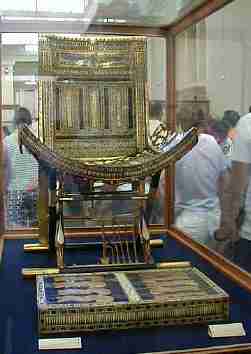Tomb of Ramses VI (Dynasty 20)
The New Kingdom kings had learned something from their predecessors: being divine is no protection from the avarice of your countrymen. The tombs of Middle Kingdom rulers, not to mention the Old Kingdom pyramids, had been plundered (often, it was probably thought correctly, by the workmen who dug the tombs in the first place). But the New Kingdom pharaohs determined to safeguard themselves and the treasures they were to take with them to the realm of Osiris by digging their tombs deep into the desert and hiding the entrances. It didn't work. With one lone exception (Tutankhamun), all of the sixty or so tombs so far discovered were thoroughly looted in antiquity.
Click here for an interactive map of the Valley of the Kings.
Click here for an answer to the question: Who really dug those tombs?
Question: Given that kings were divine and they needed all that rich stuff in the tombs for the good life in the next life, did they actually believe they'd be able to keep it all? Question two: Were the kings really thought to be all that divine by their subjects if those subjects didn't hesitate to steal their grave goods and tear open their mummies to get the amulets, gold, and gems?
| An additional-price ticket is required for "King Tut's" tomb (KV62), which seems a bit odd given the fact that there is precious little to see inside. And no camera is allowed. His body has been returned to the tomb but his grave goods, which have been seen in museums around the world, now reside in the Egyptian Museum . This chair is one example. |  |
| This boat scene from the tomb of Ramses IX (Dynasty 20) is typical of what today we call "decoration" but in the second millennium BCE was theological wisdom designed to ensure the safe transport of the pharaoh on his journey. The depiction here is of the solar boat of Khnum (one of the names for the creator god). Khnum is framed in the center with Hathor to his right and Horus to his left. Like the solar boats buried alongside the pyramid of Khufu, depictions such as this ensured that the king would merge with the sun god to travel across the sky on his daily voyage. |
| The largest tomb so far found in the Valley of the Kings (KV5) belongs to the sons of Ramses II. Ramses II, a Dynasty 19 king, was father to at least 30 sons by his principal wives plus an unknown number by minor wives and concubines and probably just as many daughters. This progeny required a number of wives, one of whom was his sister and three were his daughters. Not open to the public, KV5 has been the subject of television documentaries, numerous magazine articles, and a book by its excavator, Kent R. Weeks, entitled The Lost Tomb (New York: William Morrow, 1998). Unlike other royal tombs (except, of course, that of Tutankhamon) KV5 is the beneficiary of Weeks' flair for publicity and genuine desire to make known his discoveries in this remarkable tomb. The entrance is locked but considerably more than a peek behind the barred door is available at the KV5 web site. |